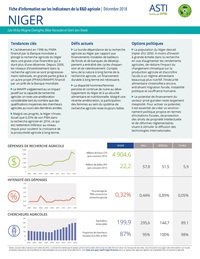Authors:
Léa Vicky Magne Domgho, Biba Yacouba et Gert-Jan Stads
Year:
2018
Publisher
Institut international de recherches sur les politiques et Institut National de la Recherche Agronomique du Niger.
Back to:
Key trends
- The completion of the World Bank–funded PNRA in 1998 plunged Niger’s agricultural research into severe financial crisis lasting more than a decade. Since 2009, agricultural research investment levels have gradually begun to recover, in large part due to another World Bank loan–funded project: WAAPP.
- WAAPP also had a positive impact on agricultural research capacity. Both the number and average qualifications of agricultural researchers in Niger improved considerably in recent years.
- Despite these positive developments, Niger still invests only 0.32 percent of its AgGDP in agricultural research, which is well below the level required to sustain long-term agricultural productivity growth.
Current challenges
- Niger’s agricultural research has been highly dependent on volatile funding from donors and development banks, leading to boom and bust cycles. Given the long-term nature of agricultural research, sustained long-term funding is required.
- Persistent gender disparities continue to challenge Niger’s development and food and nutritional security. Women remain grossly underrepresented in Niger’s agricultural research system as well, notwithstanding a recent increase.
Policy options
- Niger’s population is set to triple between now and 2050. Without large-scale investment in research to increase crop yields, combat climate change's impact on agricultural output, and increase access to more nutritional diets, the country will experience more food insecurity leading to forced migration, political instability, and human suffering.
- The private sector funding potential remains largely untapped in Niger. Cultivating private funding involves providing a more enabling policy environment in terms of tax incentives, protection of intellectual property rights, and regulatory reforms to encourage the spill-in of international technologies.

